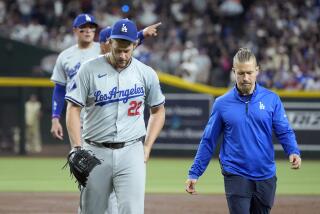Steady Shaw Hasn’t Lost His Edge
- Share via
With 26 games left, Jeff Shaw may still walk the closer’s high wire to a Los Angeles Dodger record for saves in a season, maintaining his National League lead. He may also walk the high wire right into retirement or free agency at the end of the season. Maybe some fans and talk show piranhas, feeling he has slipped and fallen off too many times, would be happy to see him go, but do they have an answer for this ...
How do the Dodgers replace those 39 saves in 46 opportunities? Can an organization with other needs afford to create a vacuum in the critical closer role? With a high payroll again next year and typically high expectations, can they turn it over to the inexperienced Matt Herges?
Shaw and the Dodgers will each have a vote in a complex decision and it may depend some on how the team finishes and how the closer finishes, and it will certainly depend on how Shaw’s family feels about the various aspects of a decision that won’t be discussed until the season is over.
Asked to grade his fourth season in Los Angeles, Shaw gave it an E.
“Enjoyable and eventful,” he said.
And effective?
“Yes,” he said. “Enjoyable, eventful and effective. I think that sums it up pretty good.”
For the closer, of course, every season is eventful. Every game. It’s do or die on the high wire.
Last week’s three-game series with the Colorado Rockies was a microcosm.
On Tuesday night, Shaw couldn’t hold a 3-2 lead in the ninth inning of what became a 4-3 loss. One pitch was hit hard, another couple softly, and Shaw walked off to boos.
On Thursday night, called to protect a 5-4 lead in the ninth, Shaw got himself into trouble. Runners at first and third. No outs. On the bench, the Dodgers were hoping for damage control, getting out with a tie.
Shaw responded.
With Todd Helton thinking only about a three-run homer and repeatedly ripping foul balls, Shaw won a 16-pitch confrontation--”a monumental confrontation,” pitching coach Jim Colborn said--by striking out one of the league’s best hitters.
Then he got the dangerous Jeff Cirillo to hit a comebacker to the mound, bobbled the ball, didn’t panic by making a hurried bid for a double play, and opted to trap the runner off third instead. He then struck out Juan Uribe, uncharacteristically pumped both arms, and walked off to cheers.
Shaw smiled, sitting at his locker the next day.
“The fans have their opinions, especially here in L.A.,” he said. “They’ll love you, they’ll boo you. They have short memories, just like closers need to have. It’s the old story, ‘What have you done for us lately?’ I mean, you can’t allow yourself to get too high or too low. There are going to be bumps in the road. If you’ve got 60 good baseballs sitting over here and three bad ones over there, why dwell on the bad ones? I’m 35. With the more years, games and success I’ve accumulated, it’s become easier to forget the bad ones and move on.”
Shaw, of course, knows the history. Todd Worrell set a franchise record of 44 saves in 1996 and was being booed toward retirement a year later. Shaw’s hope is that he can be good 90% of the time. The recognition as one of the game’s best closers?
“I don’t look at it that way,” he said. “It’s hard for me to say I’m one of the top four or five. I’m not that type person. I’m very humble. Just let me go out and do my job. You guys write what you want. Half the time I don’t read it.
“The only thing that concerns me is what my teammates feel about me, the trust, coming into a game and hearing them say, ‘Alright Shawsy, let’s go, we know it’s over, let’s go.’ That means more to me than anything.”
This isn’t Goose Gossage or the Mad Hungarian out there. Shaw doesn’t come in with speed guns blazing. He doesn’t prance around the mound. His hair isn’t billowing behind him. Shaw has a combination of pitches that require him to be precise.
Maybe it’s that lack of flamboyance, of clearly overpowering stuff, that leaves fans unsure of how to categorize and characterize Shaw and quicker to react negatively. Maybe they need to know what Colborn knows, which is that Shaw has “off-the-chart courage, very solid understanding of how he wants to attack each hitter and great command in the clutch. He’s at his best under pressure and he’s deceptively fast, sneaky fast, with a deceptive delivery.”
Shaw laughed.
“Closers are supposed to be weird, crazy, but I’m a converted closer,” he said. “I was a starter who went from the front to the back and I just feel I represent a little bit of everything. I represent a starter, mid-reliever, set-up guy and closer. I’m definitely not your prototypical closer who throws 100 [mph] and goes out there with his hair on fire. I rely on spotting the ball and having a scouting report and learning what a guy can’t hit and can. That’s my game plan.”
Shaw went from a starter with the Cleveland Indians to a middle reliever with the Montreal Expos to a successful closer with the Cincinnati Reds. He wasn’t enthused about uprooting his family from their Cincinnati-area home when acquired by interim general manager Tom Lasorda for Paul Konerko and Dennis Reyes on July 4, 1998.
He subsequently considered exercising his right to demand a trade at the end of that season (as a player traded with a multiyear contract) before he turned that right into a new deal with the Dodgers. He made $3.05 million in 1999, $5.05 million in 2000 and is making $6.05 million this year. The Dodgers have an option on next year at $7.05 million, or they can buy it out for $1.5 million. If they exercise the option, Shaw has the right to reject it. In that case, the buyout is reduced to $1 million.
“Basically, I have three choices,” Shaw said. “I can come back if they exercise the option. I can reject it and become a free agent to see what else might be out there, or I can reject it and retire.”
A family man with a son in the sixth grade, a daughter in the first and another son not yet in school, Shaw said there will be a family roundtable when the season is over. He and wife Julie still have a house in their native Ohio, but “Julie and the kids have adjusted well to L.A. I feel that I can pitch two or three more years, but I don’t want to stick around so long that I start tricking people either. The game will let you know when it’s time to leave.”
The Dodgers, of course, could force Shaw to leave, but then what? Proven closers are a rare and expensive commodity in the trade and free-agent markets. At this point, Herges would seem to be the club’s only alternative, and he would “love to have the opportunity. No middle reliever wants to stay in middle relief. We all want to be a starter or closer, and I wouldn’t be here if I didn’t think I could do it.”
In the meantime, if that’s what this is, Herges said Shaw has been “awesome about sharing his knowledge, how he prepares, how he bounces back from bad outings. There’s no other closer you’d want to learn from because he’s not the type who can just rear back and throw 100 miles per hour. He has to get outs by thinking and locating.”
Well, the fans and talking heads may not always agree, but they have the benefit of having both feet on the ground. The closer is up there on that high wire, and Shaw has reached the other end far more often than not.
More to Read
Are you a true-blue fan?
Get our Dodgers Dugout newsletter for insights, news and much more.
You may occasionally receive promotional content from the Los Angeles Times.









